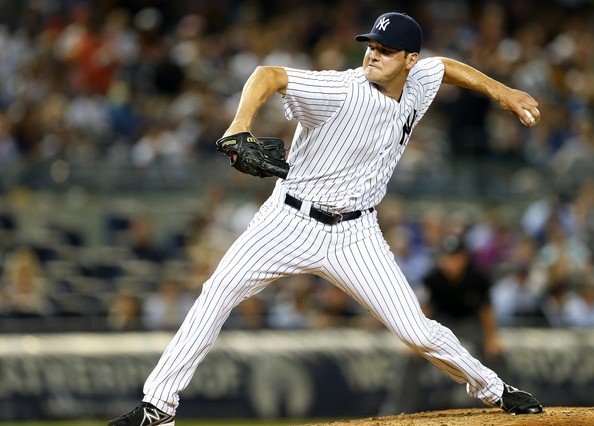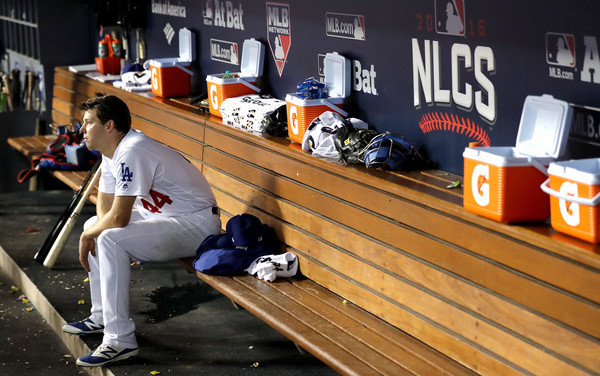
Remember when Rich Hill pitched for the Yankees back in 2014? He threw 5.1 IP of one-run ball in 14 appearances, walking three and striking out nine. The Yankees, of course, did not bring him back that offseason. That 2014 season was the final season of his very forgettable seven-year stretch in which Hill was marred by injuries and inefficiency. In those years, he threw only 153.0 ML innings total with a cumulative 5.41 ERA and 108 walks. No one was going to give serious consideration to an aging journeyman pitcher who had a 6.4 BB/9 since 2008.
As you may know, it’s been a total turnaround for Hill. In 2015, he figured some things out and got a chance with the Red Sox. He threw four stellar games for Boston (29.0 IP, 14 H, 5 ER, 5 BB, 36 K, 1.55 ERA), looking unlike the pitcher who seemed to be on the verge of irrelevancy. Those four games made him an intriguing yet uncertain player entering free agency. The A’s took a flier on him with a one-year deal and a $6 million guarantee.
Hill showed in 2016 that he can stay effective for more than just four starts. In fact, he was one of the best ML starters when healthy. Pitching for the A’s and Dodgers, he had a 12-5 record with a 2.12 ERA in 20 starts. His underlying stats (2.39 FIP) suggest it was no fluke.
I was going to name this “Is Rich Hill a fit for the Yankees?” but of course he’s a fit. A pitcher who can perform like he did in those 20 starts this year is going to be a fit for any team. It is a question of whether Yankees should take a risk and throw money at him after what he’s done in his career, specifically the past two seasons. Let’s break it down.
1. He’s really good. Perhaps good enough that Yankees should consider splurging a bit.
The Yankees have not been willing to offer a huge-money contract to a starting pitcher since, well, Masahiro Tanaka in the 2013-14 offseason. Prior to that, they were willing to break the bank for Cliff Lee but the lefty chose to play with the Phillies. They also approached and signed Hiroki Kuroda via free agency.
The common theme that I see is that you could count on solid, consistent production from those guys. Sure, Tanaka was just coming out of NPB, but many had tabbed him to be a real deal. Cliff Lee, of course, was an ace and he went on a pitch like one in Philly. Kuroda pitched four very consistent seasons for the Dodgers before coming over to New York.
The Yankees did not bother much with the Ricky Nolascos or Wei-Yin Chens of the world — guys who were above average prior to hitting the market, but would you really be comfortable giving either a five-year, $80 million contract? (That’s how much the Marlins are paying Chen by the way. He had a 4.96 ERA in 22 GS in the first year of contract.)
Sure, Hill’s track record of domination isn’t long but his 2016 season reassured us that his surge is for real. He figured something out. Unless his physical strength deteriorates big time, he should have at least a year or two of quality pitching left in tank. You want numbers on how good he is? Here are some (min. 110 IP):
- 2.12 ERA — ranks 2nd behind Clayton Kershaw
- 2.39 FIP — ranks 4th behind Kershaw, Noah Syndergaard and Jose Fernandez
- 10.52 K/9 — ranks 9th
- 0.33 HR/9 — ranks 1st. It helps that he pitched in two of the most pitcher-friendly ballparks (A’s Coliseum and Dodger Stadium), but still, a great figure.
- 22.3% soft contact rate — ranks 9th highest
- 28.3% hard contact rate — ranks 19th lowest
As you can see, Hill ranked among the top 10 in many positive stats. It’s not like he was great at just one thing, a la Michael Pineda and striking hitters out. He excelled in many facets of dominating hitters. He’s a guy that you’d give a ball to in important games ten times out of ten.
If you need a refresher on what Hill’s stuff looks like, here are all the pitches thrown from his September 10 start versus Miami.
The Yankees hold the 17th overall pick for the MLB Draft next year, which means that they will lose it if they sign a free agent that rejected the qualifying offer. New York is one of the teams that can afford to pick signability guys early and gift them with an ample bonus cash, just like what they did with Blake Rutherford, the 18th overall pick of the draft this year.
I don’t think Yankees would risk losing a pick that high for a pitcher with substantial risk. They have been collecting many young assets via the draft and trades, and I don’t see them slowing down anytime soon. Hill did not reject the qualifying offer — he couldn’t receive one because he was traded at midseason — so he won’t cost the Yankees their first round pick.
3. What about his age and health?
The thing about Rich Hill is that the man has a long enough injury history to it out on an entire roll of toilet paper. In 2016 alone, he had two separate DL stints (groin and blisters) and was limited to only 110.1 IP. The silver lining is that neither of them are serious arm issues, but they still caused him to miss an extended amount of time. One of the last things you want during the season is to have one of your best pitchers hit the disabled list, whatever the reason may be.
If the Yankees sign Hill, they will monitor his workload for sure. It’s pretty clear that the Yanks are targeting bullpen arms this offseason. If all goes as planned, they could have another ‘pen that can send an array of trustworthy arms after a 5-6 IP outing by the starter. I’m not guaranteeing that they will sign another guy beyond Aroldis Chapman/Kenley Jansen/Mark Melancon, but I think it would make sense if they do. In 20 regular season starts, Hill went 7 innings or longer only thrice. The highest pitch count he had was 112. If New York signs him, I think it is very possible that Joe Girardi will have a strict limit.
From what we can tell, Hill can give a team excellent quality innings in a limited number of starts. “Limited” is the key word here. Prior to 2016, the last time he had a 100+ IP season in pros was 2010 (103.0 IP total between AAA and MLB). In his pro career that started in 2002, only six times he managed to break the 100 IP mark. That is kind of terrifying.
Behind that number are a lot of injuries, but at the same time, he was very ineffective and also had pitched as a reliever. Perhaps we shouldn’t take the figure too seriously. It is true, however, he has limited or basically zero track record of durability. There could very well be a scenario in which he suffers a major injury early on in the contract and is never effective again. Obviously I am no Dodgers fan, but I always get wary that a free agent pitching signing could go as bad as the Jason Schmidt deal. It’s not an outcome that happens often but anything bad could happen when you take on an aging arm.

4. Do the Yankees need rotation help? (Spoiler: Yes)
As of right now, the two locks for the 2017 rotation are Masahiro Tanaka, CC Sabathia, and Pineda. Who do they have otherwise? Nathan Eovaldi will be rehabbing. Luis Severino could spend another year flip-flopping between the rotation and bullpen. Chad Green will have to earn a spot again if he recovers well from sprained elbow. Bryan Mitchell had a decent showing late in the year but I can’t say he’s locked down a rotation spot. There’s also Luis Cessa, who was decent but not a type that I’d easily guarantee a spot to.
So yeah, there are tons of question marks. At this point, you’ve gotta figure management knows that they need to make a move to improve the rotation to be competitive in 2017. As you can see the names from above, the young depth is there. It is hard to tell, at this moment, if any of them will turn out to be a reliable MLB starter for 2018 and beyond.
The Yankees would surely like to be a winning team in 2017. A Tanaka-Hill tandem would be a hoot. Hill was worth 3.8 fWAR in 2016, which is remarkable considering he only threw 110.1 IP. Getting 20 starts worth of solid production is better than none. Also, in a scenario where the 2017 Yankees tank coming into the trade deadline and Hill pitches lights out, they could explore trading him for prospects.
I think Hill is a worthy venture. He is an elite starting pitcher when healthy … for now. You never know what could happen to a pitcher turning 37. Unless he suffers a season-ending injury, a team could count on him for 100-130 IP worth of solid production. Is 150 IP out of the question? Maybe. If they monitor him well and his body doesn’t betray him, I can see Hill being a useful starter until the young guys in the organization start to make an impact. However, he hasn’t shown a track record of staying healthy as a SP for most of the season since, well, 2007.
On the other side of the coin, Hill wouldn’t require a draft pick or a trade. Just a check from the Steinbrenners. If the contract is around 3 years and $45-50 million, I say sign him. You don’t get many chances to sign a guy with such upside for that money. I don’t think money would be a huge issue for Yankees. However, I’m wondering, because of the weak starting pitching market this winter, if the Hill camp pushes the envelopes a bit and demand more annual money and/or a fourth year. I’m sure the team has done/doing/will do their research to evaluate whether Hill would be worth the risk. We’ll see what happens.
Leave a Reply
You must be logged in to post a comment.